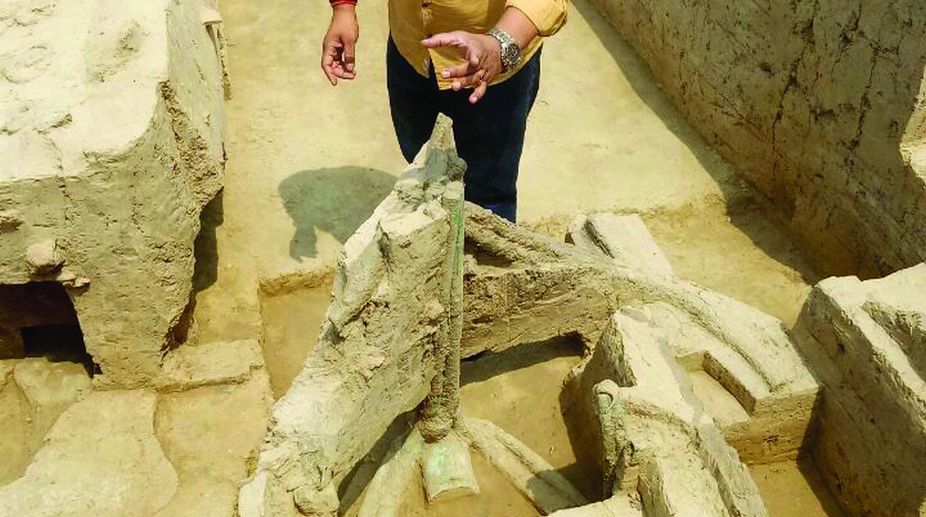In search of Indianness
India’s cultural consciousness is embedded with pearls of heritage carried forward through generations in the form of folk art.

Fields during excavations at Sinauli village of Baghpat district has opened a new chapter for archaeologists and historians.
These discoveries could be an important link between the period of second urbanisation and early time of cultural society in the Indian Subcontinent.
Enthused by the discovery of chariot , swords, shields, etc., some historians believe that it is an indicator that Mahabharata was not a legend but was part of Indian history . The discovery proves that chariots were in existence in the era of painted grey pottery much before the Mahabharata period.
Advertisement
Baghpat and the nearby areas are known for their links with the Mahabharata. There are still some sites related to the Mahabharata period like Lakshagrah in Barnawa, where according to legend the Pandavas were made to stay in a wax palace which was burnt by the Kauravas. Hastinapur in Meerut district was also an important place in the Mahabharata period. In 1952 famous archaeologist B B Lal had done an excavation which had led to interesting discoveries. Kurukshetra, where the famous battle of Mahabharata is supposed to have been held, is now in Haryana but close to Baghpat.
Sinauli became important a few years ago when a graveyard was discovered here during excavation by the Archaeological Survey of India. Ram Sharma, a farmer on whose land in 2005 the excavation was done, recalls that some skeletons were found when soil was being removed from his field. He reported the matter to local media who published pictures in their newspapers after which ASI visited the village and decided to excavate. Sharma happily offered his 3 bighas of land for excavation without expecting any money. ASI established a trench and started excavation which continued for 13 months and led to the discovery of a graveyard deep down the field.
The second phase of excavation started a few months ago under the supervision of Dr Sanjay Manjul, director of Institute of Archaeology, ASI. The excavation team discovered a chariot, a coffin, sword, shield and helmet and other things.
This excavation is going on in the field of Satendra Mukhia, a farmer, and his two brothers and the entire family has extended their full support and cooperation to ASI officials and trench digging experts in the past three months. “They have been very supportive,”, said Dr Manjul.
Three months ago Mukhia found pieces of copper and approached ASI officials. After examining the recovered copper pieces Dr Manjul decided to dig a trench and Mukhia happily offered about 500 square metres of land to them in his field. The excavation started, digging out some astonishing secrets from the the belly of the earth. The ASI experts were amazed to find three chariots, two coffins, swords, beeds, helmets and many other things which indicate that a warrior culture existed here between 2000 to 1800 BC. “Chariots were never found in Indian Subcontinent in excavations along with swords, shields and coffins which indicate that a warrior class was existing here during 2000 to 1800 BC in the post-Harrappan period,” said Dr Manjul, adding that the Harappan civilisation is believed to have had an advanced culture and discovery of combs, mirrors, etc., indicate that the society here was also very advanced.
“The 5000 year old chariot of an advanced copper age civilisation which thrived in Western Uttar Pradesh and Haryana contemporary to the Indus Valley Civilisation and part of the same overall cultural sequence has become evident with this excavation,” said historian Amit Pathak.
Pathak said the coffin of a warrior king of 6 feet height in copper with his sword, shield, copper helmet, chariot, a dog and a bird was also found there. The height of the king was about 6 feet. All other burials found here earlier were without coffins. This coffin had copper motifs and designs including that of a horned headress and Peepal leaf.
Historian K K Sharma said finally there are indications that Mahabharata was not legend but part of history. “A school of historians has often ignored the existence of Mahabharata by describing it as a story. But discovery of chariot, coffin, swords, shields in a single burial pit indicates that Mahabharata was also history, not story,” he averred .
Dr Manjul asserted that the discovery indicates that even chariot was available here much before Mahabharata which belongs to the era of painted grey pottery. He said it is too early to link it with the Mahabharata but the discoveries have opened a new dimension of ancient Indian history.
Advertisement